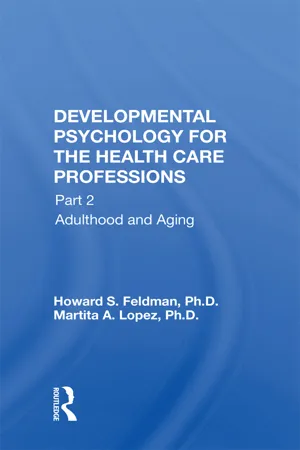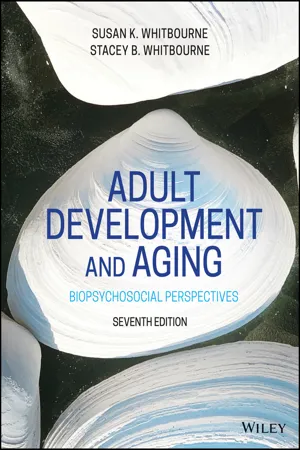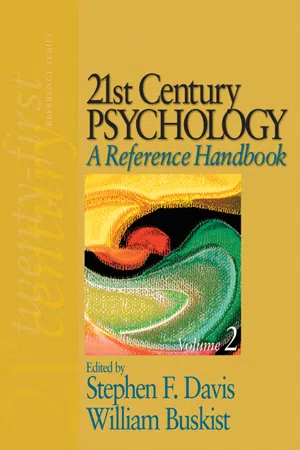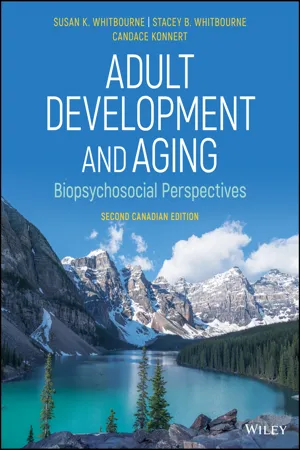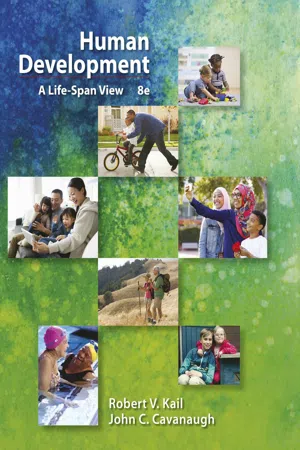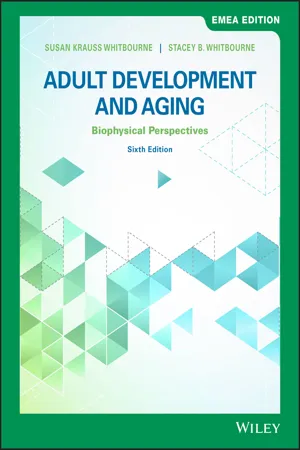Psychology
Adulthood and Aging
Adulthood and aging refer to the developmental stage and process of growing older, encompassing physical, cognitive, and psychosocial changes. This period involves transitions such as career advancement, family formation, and retirement, as well as adjustments to declining physical abilities and potential health challenges. Psychological research explores the diverse experiences and factors influencing individuals as they navigate this life stage.
Written by Perlego with AI-assistance
Related key terms
1 of 5
10 Key excerpts on "Adulthood and Aging"
- Available until 4 Mar |Learn more
Developmental Psychology For The Health Care Professions, Part Ii
Young Adult Through Late Aging
- Howard. S. Feldman(Author)
- 2020(Publication Date)
- Routledge(Publisher)
1 A Developmental Perspective on AdulthoodIntroduction
Since the 1960s, there has been growing interest in and research on the adult years of the life cycle. Previously, developmental studies had focused on childhood and adolescence, in which an orderly relationship between age and growth was assumed. Adulthood had been looked at as a time of stability, the end point of earlier developmental processes. The changes presumed to occur during adulthood were typically seen as centering around issues of deterioration that take place gradually, universally, and in an age-related pattern. These assumptions are now being challenged, and the span of time between early adulthood and ultimate death has become an area of great research activity. The new orientation looks at human development as a life-long process with change taking place throughout every phase, and its goal is to identify which changes take place at which points in the life course and to establish the nature of the patterns and interrelationships of these changes. Throughout adulthood, individuals experience growth, stability, stagnation, and deterioration in many aspects of their lives. These processes are subject to an intricate interaction between biological, psychological, and socioenvironmental factors.We will be looking at three periods of adulthood identified on the basis of chronological age: young adulthood, from 18 to 40; middle adulthood, from 40 to 65; and later adulthood, from 65 until death. This division is somewhat arbitrary, although it has heuristic value; issues and events actually overlap these periods and may occur repeatedly throughout adulthood. The first chapter provides a general overview of adult developmental psychology and explores physiological changes in young and middle adulthood. The second and third chapters explore young and middle adulthood, respectively, and examine psychological issues that are dealt with during those periods, as well as the adult's involvement in relationships and work. The next three chapters focus on later adulthood, with the fourth looking at the relationship between health and aging and the fifth examining the research on cognitive changes that take place in later adulthood. The last chapter explores psychosocial processes such as coping, adaptation, retirement, and death in old age. - No longer available |Learn more
- Philip Banyard, Christine Norman, Gayle Dillon, Belinda Winder, Philip Banyard, Christine Norman, Gayle Dillon, Belinda Winder(Authors)
- 2019(Publication Date)
- SAGE Publications Ltd(Publisher)
This long phase of life is becoming even longer as the average lifespan increases. People’s roles and responsibilities can change dra- matically in the course of adulthood, as can people’s views and aspirations. This period of life is set to be studied more thoroughly even as it continues to be seen as a bridge between youth and old age. 20.3 AGEING People are living longer and population ageing is a global phenomenon, which has profound implications for society. In 2017 there were over 15.3 million people aged 60 years and above in the UK (Office for National Statistics, 2017). The UK Office for National Statistics estimates that by 2030 the number of people aged 60 and over will reach 20 million people. This trend poses a number of challenges, including limiting the potential for economic and social burden, increasing longevity and quality of life for older adults, and maximising the positive contributions that older adults can make to society. It is important to under- stand the key concepts in the psychology of ageing, especially when taking into account 500 DEVELOPMENTAL PSYCHOLOGY the increasing importance of older age groups in society. If the effects of ageing are fully understood, healthy and successful ageing and a better quality of life in older age may be promoted. Fortunately, research into the psychological effects of ageing has seen an increase in recent years and therefore we are now beginning to understand the important psychological issues around ageing. For more information, take a look at Video 20.1 on the website. 20.3.1 Conceptual bases, theories and models of ageing or older adulthood There are a number of different approaches to the study of ageing, including biological, social and psychological. The aim of ageing theories is often to provide a framework for understanding the ageing process and the factors which influence the ageing process. - eBook - ePub
- Irving B. Weiner, Richard M. Lerner, M. Ann Easterbrooks, Jayanthi Mistry(Authors)
- 2012(Publication Date)
- Wiley(Publisher)
when (at what lifespan inflection points) substantial changes in group and individual cognitive trajectories occur. Substantial changes refer to those developments that are not only detectable but also descriptively informative, theoretically meaningful, or clinically significant.Cognitive aging (the field) is a particularly active and vibrant domain of research, one that is at the crossroads of both classic questions and novel trends. Several brief examples of each of the paths leading to this crossroads may be useful. First, classic questions about cognitive aging revolve around core developmental issues such as directionality (i.e., whether adult cognitive changes are gains, losses, or maintenance), universality (i.e., the extent to which there are individual differences in profiles of changes throughout adulthood), and reversibility (i.e., whether experience or intervention may promote recovery or improvement in functioning). For more than a century, scholars have wondered whether the lengthening adult life span would be ineluctably accompanied by diminishing cognitive, social, institutional, and other resources (Baltes, Lindenberger, & Staudinger, 2006; Birren & Schroots, 2001). Moreover, because contemporary (Western) adulthood represents about 75% of the normal expected life span, few adults would fail to have a vested interest in the cognitive changes they might expect as they grow through their middle and into their later years. Second, novel trends reflect influences that are easily and importantly incorporated into research on cognitive aging (as is the case for earlier periods of life). Recent trends include methodological advances, such as the means of detecting and analyzing structure, change, and variability (e.g., Hofer & Sliwinski, 2006; McArdle, 2009). Other novel trends in cognitive aging are often adapted from neighboring disciplines and given new clothing in the context of understanding long-term change. Among notable developments are such integrated topics as metamemory and memory compensation (e.g., Dixon & de Frias, 2007; Hoogenhouts, van der Elst, de Groot, van Boxtel, & Jolles, 2010), neurobiological, neurodegenerative, and neurogenetic influences (e.g., Bäckman & Nyberg, 2010; National Institute on Aging, 2008), other biomarker and health modulators (Anstey, 2008; Spiro & Brady, 2008), psychosocial, motivational, and emotional influences (e.g., Heckhausen, Wrosch, & Schulz, 2010); social, interactive, and collaborative contexts (e.g., Dixon, 2011a; Gerstof, Hoppmann, Anstey, & Luszcz, 2009; Rauers, Riediger, Schmiedek, & Lindenberger, 2011), interventions and training (Lövdén, Bäckman, Lindenberger, Schaefer, & Schmiedek, 2010), and successful or healthy directions of cognitive aging (Baltes & Baltes, 1990; Dixon, 2010). Overall, how, why, and when cognition changes with aging are seen as integrated developmental questions—questions that reflect classic developmental issues and relate to numerous neighboring developmental processes. Indeed, issues considered in the study of cognitive aging go to the heart of our view of both the human life course, in general, and of developing (aging) adults, in particular. - eBook - PDF
Human Behavior and the Social Environment
A Perspective for Social Work Practice
- Grace Ganter, Margaret Yeakel(Authors)
- 2019(Publication Date)
- Columbia University Press(Publisher)
Adulthood 211 From this perspective, adulthood is the end of the line, and every-thing that happened before is significant primarily because it got us there. Once there, we have no place to go but down. 1 She has also noted that criteria for identifying changes in adulthood that are developmental raise questions about what changes occur, and what differentiates adults from adolescents or children. We approach this chapter, then, with some islands of knowledge between which bridges have not yet been built. The explanations we offer are provided by a number of authors who have studied different aspects of adult behavior, and they include some of our own impressions of the propelling and restraining forces which determine the extent to which adults are free to move their own humanness ahead. We have selected certain issues which we see as important to social workers' knowledge as they bring their own life and practice experience to bear on formulating their understanding of this life stage, and as they increase their knowledge through further explora-tion of the insights available in a widely scattered literature. Defining Adulthood No sudden cut-off point in the search for identity defines the close of adolescence and the beginning of adulthood. The rapid onslaught of physical maturation and preoccupation with body image has presumably been lived through in adolescence. People may feel confident and good about themselves, or uncertain and frightened by the implications of compromises they have made during the teen-age years. They may become adults in good faith with themselves, or they may be pressured to conform to rules and roles that restrain further self-develop-ment. They may be so heavily influenced by past experience as to have no expectation of growing and changing. They may have made gradual transitional changes from one stage to the next without undue stress, and find the transition to adulthood smooth and easy. - eBook - PDF
Adult Development and Aging
Biopsychosocial Perspectives
- Susan K. Whitbourne, Stacey B. Whitbourne(Authors)
- 2020(Publication Date)
- Wiley(Publisher)
It’s almost impossible to be a gerontologist without applying this integrative view to your work. Knowledge, theories, and perspectives from all disciplines contribute importantly to the study of the individual over time. Gerontology is distinct from geriatrics, which is the medical specialty in aging. To help put it all together for you as you develop throughout adulthood, we will pay special attention to the concept of identity. Identity is defined as a composite of how people view themselves in the biological, psycholog- ical, and social domains of life. The interaction of these domains forms an overall view of the ‘‘self.’’ FOUR PRINCIPLES OF ADULT DEVELOPMENT AND AGING We begin our study of adult development and aging by sharing a set of four principles that form the foundation of our biopsychosocial approach (see Figure 1.2). As you read the book, you’ll find that we return frequently to these principles, which we highlight when they appear in the chapter. If you begin to understand them now, you will find the course material much easier to master. Principle 1: Changes Are Continuous Over the Life Span First and foremost, changes over the life span happen in a continuous fashion. According to the continuity principle, the changes that people experience in later adulthood build on the experiences they had in their earlier years. This means we can never isolate the later years of life without considering the years preceding them. Since time moves FIGURE 1.2 The Four Principles of Adult Development and Aging Changes are continuous over the life span Only the survivors grow old Individuality matters Normal aging is different from disease in a forward direction, the changes throughout life build upon themselves in a cumulative fashion. If you were hard on your body as a young adult, chances are the changes you’ll undergo when you’re older will be more negative than if you took good care of yourself. - Stephen F. Davis, William Buskist, Stephen F. Davis, William F. Buskist(Authors)
- 2007(Publication Date)
- SAGE Publications, Inc(Publisher)
A researcher using this design type and again testing intelligence might start off with people who are 0, 40, and 60 years of age, testing them at the same time (cross-sectional) and then in 1 year, years, or more test the same groups again (longitudinal). This approach has all the advantages and disadvantages of cross-sectional and longitudinal approaches, but it will provide informa-tion that neither of these can gather alone. It is only with these research approaches, as along with the traditional use of experimental and descriptive research methods, that researchers can obtain answers concerning adult development. These approaches have yielded valu-able information concerning the developmental issue of stability versus change, different theoretical perspectives and theorists, as well as the impact of Adulthood and Aging on physical, cognitive, and social development. APPLICATION AND COMPARISON Many theories of aging have described successful aging in terms of avoidance of disease, being actively involved in society, and being able to function well both cognitively and physically (Kinsella & Phillips, 005). Thus, research findings can be divided into three main areas within adult development: physical, cognitive, and social. Physical Changes Many physical changes take place as a person ages. Some of these changes are readily apparent whereas oth-ers are not so easily seen. Examples include research on bodily changes, sleep patterns/disturbances in sleep, eating habits, exercise, substance use and abuse, as well as health and disease. Bodily Changes Many researchers believe that humans cannot live more than approximately 10 years. This figure seems to be the upper limit of the human life span. Currently, the average life expectancy is far below that number. The average life expectancy in the United States is 77.9 years; women and men born in 004 have a life expectancy of 80.4 and 75.- eBook - PDF
Adult Development and Aging
Biopsychosocial Perspectives
- Susan K. Whitbourne, Stacey B. Whitbourne, Candace Konnert(Authors)
- 2015(Publication Date)
- Wiley(Publisher)
Those who are able to make accommodations to age-related changes without becoming overwhelmed or preoccupied will be able to re-establish a sense of well-being after what may be an initially difficult period. Although the SOC model may seem to present a nega- tive view of aging, in that it emphasizes the way that peo- ple adapt to loss, it can also be seen as offering a realistic perspective of the fact that there are losses in adulthood that can often outweigh the gains (Heckhausen, 1997). However, people adapt to these changes by readjusting their goals and, in the process, can maintain their sense of well-being (Frazier, Barreto, & Newman, 2012). BIOLOGICAL APPROACHES TO AGING IN ADULTHOOD Biological changes throughout later life, as is true in the years of infancy, childhood, and adolescence, are based on genetically determined events or changes in physi- ological functioning brought about by intrinsic changes within the organism. Inevitably, the body’s biological clock continues to record the years. As we discussed at the beginning of this chapter, however, the interaction- ist model of development predicts that environmental factors influence the expression of biological or genetic predispositions. According to the principle of reciprocity, people’s actions interact with their genetic inheritance. The result is that relatively large individual differences occur in the nature and timing of age-related changes in physical and cognitive functioning. Ultimately, the aging of the body sets the limit on life’s length, but people can compensate through behavioural measures for many of the changes associated with the aging process to alter the timing of these events. Acknowledging the role of biology begs the ques- tion, “Why do living organisms grow old and die?” If you are a fan of science fiction, you have surely read stories of a world in which aging does not occur, or occurs so slowly that people live for hundreds of years. - eBook - PDF
- Susan K. Whitbourne, Stacey B. Whitbourne, Candace Konnert(Authors)
- 2021(Publication Date)
- Wiley(Publisher)
It may be difficult at first, but people who are able to make accommodations to age-related changes without becoming overwhelmed or preoccupied will be able to re-establish their sense of purpose and well-being. Although the SOC model may seem to present a negative view of aging, in that it emphasizes the way that people adapt to loss, it can also be seen as offering a realistic perspective on the fact that there are losses in adulthood that can often outweigh the gains (Heckhausen, 1997). However, people adapt to these changes by readjusting their goals and, in the process, can maintain their sense of well-being (Frazier et al., 2012). BIOLOGICAL APPROACHES TO AGING IN ADULTHOOD Biological approaches to aging tackle the fundamental question of why the body changes over the course of life. As stated by Stanford University’s Walter Bortz (2010, p. 383): ‘‘What are the generic properties of life, which establish its essence? What is aging? Whatever the answer, it must transcend biology as everything in the universe ages, galaxies, canyons, Chevrolets, redwoods, and turtles.’’ For reasons we don’t now understand, 36 Models of Development: Nature and Nurture in Adulthood the body’s biological clock continues to record the years with the passage of time. Ultimately, the aging of the body sets the limit on life’s length, but most gerontologists agree that people can compensate through behavioural measures for many of the changes associated with the aging process to alter the timing of these events. Acknowledging the role of biology begs the question: Why do living organisms grow old and die? If you are a fan of science fiction, you have surely read stories of a world in which aging does not occur or occurs so slowly that people live for hundreds of years. While these fictional accounts may be engrossing and even tempting to imagine, there are some obvious problems associated with such a world. - eBook - PDF
Human Development
A Life-Span View
- Robert Kail, John Cavanaugh(Authors)
- 2018(Publication Date)
- Cengage Learning EMEA(Publisher)
446 PART THREE: YOUNG AND MIDDLE ADULTHOOD and work, and it predicts physical health. Considered together, these findings provide con-siderable support for Erikson’s contention that the central concerns for adults change with age. However, the data also indicate that generativity is more complex than Erikson originally proposed and, while peaking in middle age, may not diminish in late life. Life Transition in Midlife We have seen that theorists such as Erikson believe that adults face several important challenges and that by struggling with these issues, people develop new aspects of them-selves. Erikson’s notion that people experience fundamental changes in their priorities and personal concerns was grounded in the possibility that middle adulthood includes other important changes. Carl Jung, one of the founders of psychoanalytic theory, believed that adults may experience a midlife crisis. This belief led to the development of several theo-ries suggesting that adulthood consists of alternating periods of stability and transition that people experience in a fixed sequence. Despite its appeal, though, there is no such thing as a universal midlife crisis. Instead, Labouvie-Vief and colleagues (e.g., Grühn et al., 2013; Labouvie-Vief, Grühn, & Mouras, 2009) offer some good evidence for a reorganization of self and values across the adult life span. They suggest that the major dynamic driving such changes may not be age-dependent but may fol-low general cognitive changes. Middle-aged adults show the most complex understanding of self, emotions, and motivations. Cognitive complexity also is shown to be the strongest pre-dictor of higher levels of complexity in general. From this approach, a midlife “crisis” may be the result of general gains in cognitive complexity from early to middle adulthood. This increase in cognitive complexity may help people make what could be called midlife corrections. - eBook - PDF
Adult Development and Aging
Biophysical Perspectives
- Susan K. Whitbourne, Stacey B. Whitbourne(Authors)
- 2020(Publication Date)
- Wiley(Publisher)
Psychologists approach aging by focusing on the changes that occur over time in the individual’s self-understanding, abil- ity to adjust to life’s challenges, and perspective on the world. Erikson's Psychosocial Theory According to developmental psychologist Erik Erikson (1963), people pass through a series of eight stages as they progress from birth through death. A psychoanalyst by training, Erikson attempted to understand how people navigate the major life issues that they face when they encounter each of life’s new challenges. Erikson’s psychosocial theory of development pro- poses that at certain points in life, biological, psychological, and social changes come together to influence the individ- ual’s personality. He defined each stage of development as a ‘‘crisis’’ or turning point that influences how people resolve the issues they face in a particular period in life. The ‘‘crisis’’ is not truly a crisis in the sense of being a catastrophe or disaster. Instead, each psychosocial stage is a time during which the individual may move closer to either a positive or negative resolution of a particular psychosocial issue. Figure 2.4 illustrates the eight-stage matrix. Erikson maintained that these stages are universally experienced, although the way in which individuals nego- tiate them may vary. The epigenetic principle asserts that each stage unfolds from the previous stage according to a predestined order. These stages are set in much the same manner as the programming for the biological development of the individual throughout life. They are built, according to Erikson, into the hard-wiring of the human being. The earliest four stages are central to the adult’s ability to build a solid sense of self and engagement with oth- ers. Basic trust vs. basic mistrust involves the infant’s establishing a sense of being able to rely on care from the environment (and caregivers).
Index pages curate the most relevant extracts from our library of academic textbooks. They’ve been created using an in-house natural language model (NLM), each adding context and meaning to key research topics.
